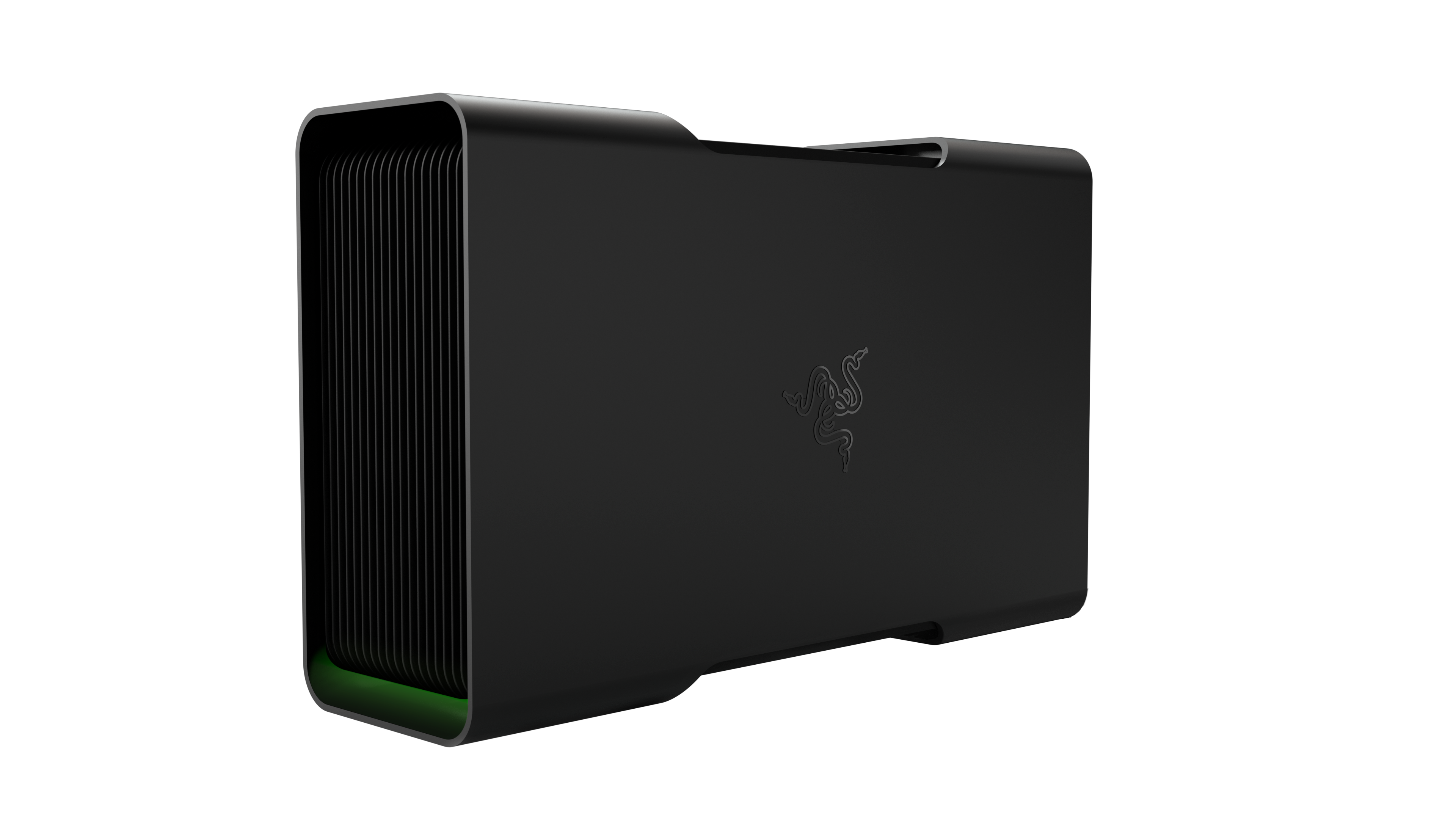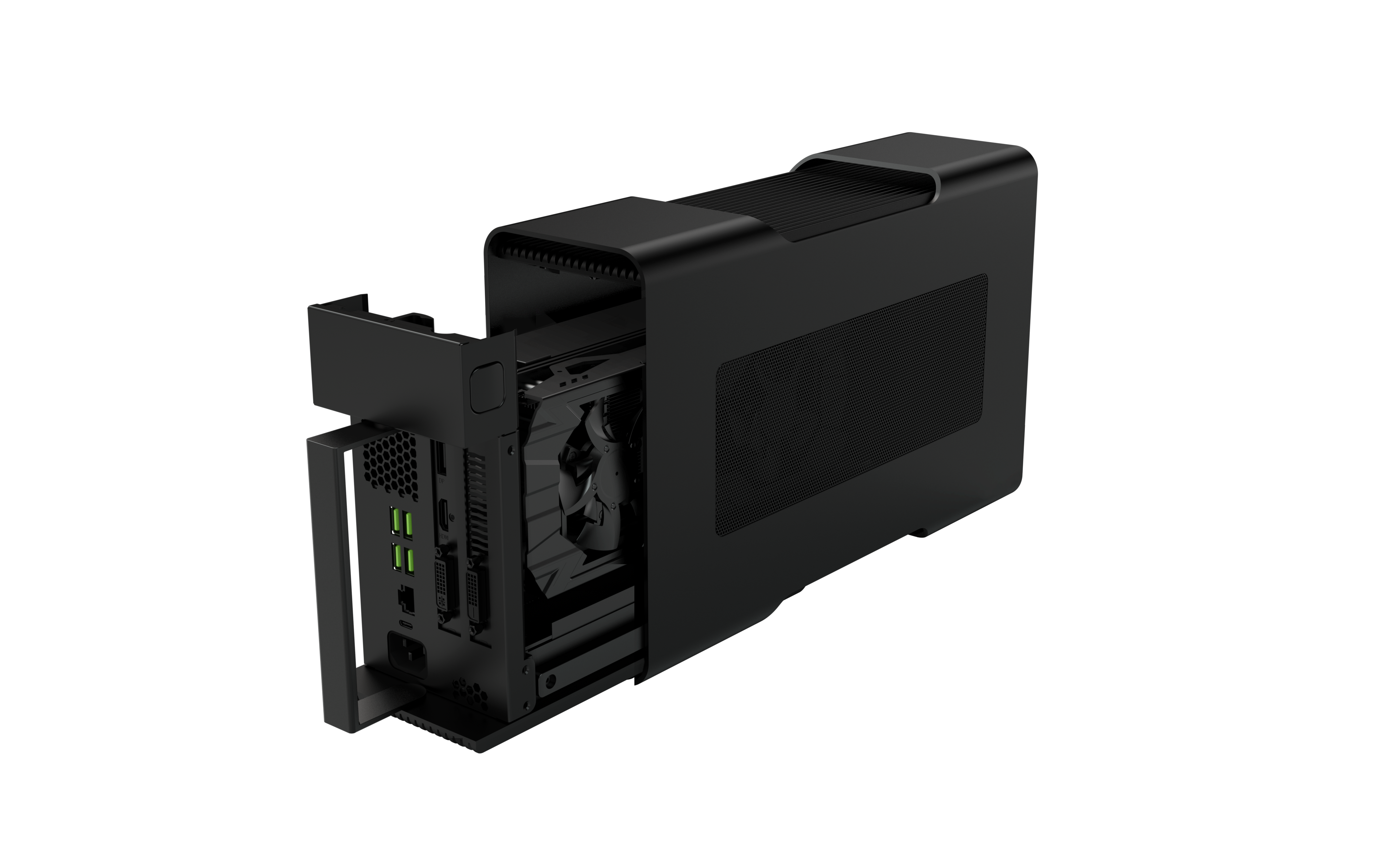Razer Core External GPU Dock: Supported GPUs, High Price Tag Revealed
Razer finally announced some long-awaited details about its Razer Core GPU dock, including the supported GPUs, the (ouch, very high) pricing, and availability.
Pricier Than We’d Hoped
When Razer first announced the Razer Core along with the Razer Blade Stealth Ultrabook at CES, I was hoping for a sub-$200 price tag, assuming one would need to drop a significant amount of money on a graphics card -- in addition, obviously, to the $1,000-plus cost of the Blade Stealth itself (or now, the new Razer Blade).
However, at least one commenter on our original article (H/T to bak0n) more correctly predicted a higher price tag, and indeed, the Core will cost a beastly $499. That’s without a graphics card.
However, the Core is compatible with both the Razer Blade Stealth and new Razer Blade, and if you order a Core along with one of them, you’ll get $100 off. That deal is retroactive to those who have already ordered one of those systems.
Preorders start today on Razer's site, and your Core will arrive sometime in April.
Supported GPUs
Ignoring the gut-punch price tag for a moment, Razer also announced which GPUs the Core will support at launch. It will support AMD Radeon 300-series GPUs for sure, but also some 200-series, Fury and Nano products. For team green, support is baked in for Maxwell-based cards.
Support is limited to graphics cards demanding a max of 375 W and measuring no more than 12.2 x 5.98 x 1.73 inches / 310 x 152 x 44 mm. It can accommodate double-wide cards, though.
Get Tom's Hardware's best news and in-depth reviews, straight to your inbox.
| AMD | Nvidia |
|---|---|
| R9 Fury | GTX Titan X |
| R9 Nano | GTX 980 Ti |
| R9 300 Series | GTX 980 |
| R9 290X | GTX 970 |
| R9 290 | GTX 960 |
| R9 280 | GTX 950 |
| -- | GTX 750 Ti |
| -- | GTX 750 |
The Specs
As any good dock must, the Core offers a number of additional ports. It also sports its own 500 W PSU. It’s also simple and easy to remove and add cards, as we saw at CES.
| Header Cell - Column 0 | Razer Core External GPU Dock |
|---|---|
| PC Connection | USB Type-C w/ Thunderbolt 3 cable |
| I/O | -4x USB 3.0-1x USB Type-C (for PC connection)-Gigabit Ethernet 10/100/1000 |
| PSU | 500 W |
| Lighting | Razer Chroma (two zones) |
| Dimensions | 4.13 x 13.9 x 8.66 inches / 105 x 353 x 220 mm (WxDxH) |
| Weight | 10.89 lbs. / 4.94 kg |
| Price | $499 ($399 with purchase of supported Razer notebook) |
Core Coming To Other Laptops?
We’re inferring somewhat here, but we expect that at some point, you’ll be able to purchase the Razer Core by itself and use it with other companies’ laptops.
First of all, Razer made a clear delineation between the price of the Core alone and the $100 off deal when you buy it with one of the two supported notebooks. Why have those two price tiers unless the Core would be able to work with other laptops? (A wild guess is that perhaps Razer’s new buddy, Lenovo, could use the Core along with the next generation of its higher-end laptops.)
Further, Razer has been clear that it wanted to use open standards with this product. As I stated yesterday in the Razer Blade launch announcement, why bother with standards if you’re going to couple the dock with just a couple of your own systems?
OEMs would have to do a bit of work to ready their systems to work with the Core, but it’s by no means a massive undertaking. Apparently, a given system would simply need to offer a USB Type-C port equipped with Thunderbolt 3 and ensure compatibility with AMD’s XConnect technology (that was fast) and the list of supported graphics cards (above).
What of Nvidia? We know that Razer has been working with the company on compatibility, particularly as it pertains to plug-and-play functionality. The Core is designed such that you can hot-plug your laptop into the dock and even hot-swap graphics cards without rebooting. The issue they’re dealing with is that because some laptops, such as the Blade, have discrete GPUs, the switching between internal and external GPUs needs smoothed out. It only affects the plug-and-play feature, we’re told. Apprently, Nvidia will fully support the Core (and the graphics switching) by the time it ships in April.
It’s also highly doubtful that AMD would bother crafting XConnect, a technology that is ostensibly designed to enable external GPU docks, just for a couple of Razer products. The same is true of Nvidia and its hand-in-hand work with Razer on the graphics switching issue. No, AMD and Razer (and to a lesser extent perhaps, Nvidia) are at the forefront of a new computing concept, pushing it forward.
And if you buy the Core and a Blade Stealth Ultrabook or new Blade laptop, you’re going to pay a premium for the bleeding edge.
Seth Colaner is the News Director for Tom's Hardware. Follow him on Twitter @SethColaner. Follow us on Facebook, Google+, RSS, Twitter and YouTube.
Seth Colaner previously served as News Director at Tom's Hardware. He covered technology news, focusing on keyboards, virtual reality, and wearables.
-
rhysiam Wow that is expensive! It's not that difficult to put together a cheap i5 build with an OS for under $500 (before you add the graphics card). I realise this has the benefit of portability if you already own the laptop, but wow... that's a lot of money. I can't imagine the BOM is anywhere near $500, so hopefully competition and recouped R&D will see prices drop significantly in future.Reply -
turkey3_scratch $500? Are you kidding me? You can get a full desktop for that price without the GPU, and the GPU is additional cost anyway.Reply
I also find it funny their "500W" power supply supports cards up to 375W. Sounds like this $500 premium doesn't even come with a good quality power supply. -
MasterMace Not surprised that if Razer made it to the market first they would set a high tag on thisReply -
thexjacob I have to say, I'm not shocked at all I had it at being about that much, I assumed that the entire set up without the graphics card would cost about as much as razer blades have cost in the past, which is about 1500-2000 dollars.Reply -
bak0n Was between this and the Alienware 15. I got tired of waiting and got the Alienware. Glad I did.Reply -
afgpdd Reply$500? Are you kidding me? You can get a full desktop for that price without the GPU, and the GPU is additional cost anyway.
I also find it funny their "500W" power supply supports cards up to 375W. Sounds like this $500 premium doesn't even come with a good quality power supply.
It also needs to supply around 100W to the notebook, so it's probably a pretty good PSU.
-
RonRave This seems insanely high (coming from someone who was already expecting a premium price). Ostensibly, the only proprietary tech here is some sort of PCIe to Thunderbolt converter - I can buy a Micro ITX case, 500w PSU, GTX 970 for $500 - all you'd need it whatever allows that conversion.Reply -
turkey3_scratch I don't think it powers the notebook, only the cards. And no, PSUs like this are basically never good. Just look at prebuilt computers, do you ever see a good one in those? Maybe once in a blue moon, in a $2500 machine, but typically they are poor.Reply -
Spectre694 Reply$500? Are you kidding me? You can get a full desktop for that price without the GPU, and the GPU is additional cost anyway.
I also find it funny their "500W" power supply supports cards up to 375W. Sounds like this $500 premium doesn't even come with a good quality power supply.
That is about right that 500W PSU powers the GPU, dock, USB peripherals and the notebook itself plus a little overhead so it isn't running at 100% all the time. 500W is about what it should be. Little less than what some of those cards ask for in a desktop.




